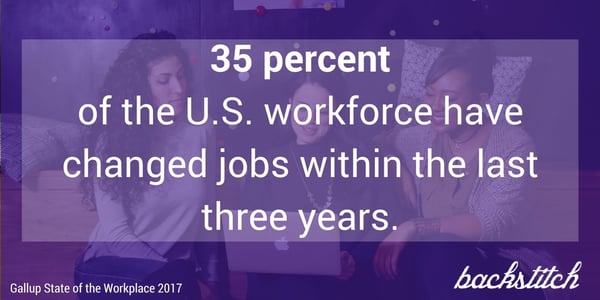Of course, every organization wants to do what it can to attract the highest quality employees.
But once your team is strong, what can you do to keep your top talent engaged? According to a 2017 study by Gallup, 68 percent of U.S. employees believe that they are overqualified for their current job.
In these cases, employees have more education and experience than what’s required for the role.
If this is true, then what is keeping those overqualified workers in their current role? Sometimes, it’s the state of the economy. And other times, these individuals truly love working with their organization, leadership and team.
But for many organizations, the improving economy is becoming a real threat to employee retention. Studies show that employees are more likely to job hop than they have been in past years. In fact, 35 percent of the U.S. workforce have changed jobs within the last three years.

What would happen to your organization if all of your “overqualified” workers left?
Also read: How to Switch Your Mindset From Recruitment to Retention
There are two things every organization must do if they want to hold onto their most qualified employees and cultivate loyalty:
Career Development Opportunities
The simple answer? Offer career development opportunities.
If your employees don’t feel like they are being challenged on the job, it can lead to disengagement and idle work time, both of which costs money.
Disengaged employees can be defined as an employee that is checked out and disinterested in company success. Instead of pouring energy and passion into the company, they give nothing other than their time.
Idle workers are employees who don’t have enough work to fill their time and are left with hours of meaningless idle time each week.
Career development opportunities, can keep overqualified workers challenged, engaged and productive.
Some examples include access to: mentoring, educational opportunities, industry conferences, self assessments and other company programs. Any tool that you give to an employee that sharpens their skills and benefits their career path, is considered career development.
If your executive leaders think that investing in career development is a sunk cost, think again.
Corporations waste about $100 billion per year on idle workers, according to a study by the University of Texas. Also, Gallup estimates that actively disengaged employees cost the U.S about $550 billion in lost productivity per year.
Offering career development opportunities isn’t just best for your organization — it’s what your employees want.
Over the past eight years, the percentage of employees considering career advancement opportunities as very important to their job satisfaction has risen by almost 20 percentage points.
In addition, more than half of employees, 55 percent, rated opportunities to use their skills and abilities at work as the most important contributor to their job satisfaction.
If your organization is employing top talent without offering them opportunities to grow, then don’t be surprised if they begin to look elsewhere for those opportunities and leave your company behind.
Flexibility
The second thing you have to make sure you offer high performing employees is flextime.
Contrary to a set schedule, flextime can be defined as a system in which employers and employees agree upon a set number of working hours that must be completed within a wider start and stop time.
Flextime is growing in popularity and is becoming more expected amongst the workforce — especially those with more skill and education.
In fact, 51 percent of U.S. employees say they would switch to a job that allows them flextime, and 37 percent would switch to a job that allows them to work off-site at least part of the time, according to Gallup’s 2017 State of the Workplace.
If your employees don’t feel challenged on the job and are getting their work done quickly, then they should be rewarded for their efforts. Offering flextime is a great way to employees feel appreciated and respected, which can increase retention.

